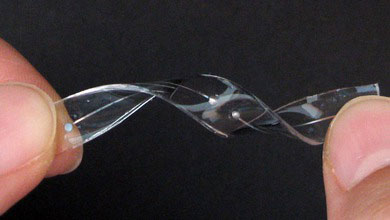Antenna easily changes shape
A type of antenna that can change shape has been built in the United States.
Antenna is present in everything, from receiving radio signals, mobile phones to global positioning devices. Now, US scientists are making shape-shifting antennas, paving the way for a host of new applications, from public security to military operations.
Modern antenna is usually made of copper or other metals, limited in terms of bending and elasticity before completely breaking. The research team at the University of North Carolina created an antenna that uses a type of alloy that can 'bend, stretch, cut and twist but still reverts to its original form', described by Dr. Michael Dickey - fellow research author.

The new type of antenna made by injecting an alloy of gallium and indium - two metals that retain liquid state at room temperature - into microscopic channels with a hair-width width. These channels are like a straw with two ends connected but can form any shape. When pumped into that channel, the oxidized alloy surface forms a 'leather' layer that holds the alloy in place while still allowing it to retain the properties of the liquid. In their study, American experts pumped alloy into the elastic silicone channel and created an antenna that was incredibly elastic and could be molded into many different shapes.'This elasticity is especially important for antennas because of the frequency of the antenna specified by its shape. Therefore, you can calibrate antenna by stretching it out , 'said Dickey.
While alloys help create an efficient antenna that can be used in a wide range of existing electronics, its durability and resilience also pave the way for many new applications. For example, an antenna with a flexible silicone cover can be used to monitor civil construction works such as bridges and bridges. When the bridge expands, the antenna can be stretched and its frequency will also change, and provide radio information to engineers about the condition of the bridge.
Flexibility and durability are also ideal properties for military equipment because this antenna can be folded or rolled into small pockets when operating and then opened for normal use. Dr. Dickey's team is continuing to work on understanding the properties of gallium-indium alloys as well as how to utilize it to make other useful devices.
- Students of automatic antenna design
- The 'paper' antenna collects energy around it
- Wireless antenna transplant to monitor cerebral aneurysms
- Waterproof fabric antenna
- These plants are frightening in shape
- Typhoon Haiyan collapsed Uong Bi TV antenna antenna column
- Why should I plug in a headset to hear the FM radio on my phone?
- Nano antenna converges laser light
- NASA makes new wings to help lighten the plane as birds
- Camouflage art of caterpillars
- The object looks like a 5,000m high antenna on the Moon
- Breakthroughs help artists 'listen' to colors
 Daily use inventions come from universities
Daily use inventions come from universities Special weight loss device helps prevent appetite
Special weight loss device helps prevent appetite 8 inventors were killed by their own inventions
8 inventors were killed by their own inventions Iran invented a motor car powered by water
Iran invented a motor car powered by water